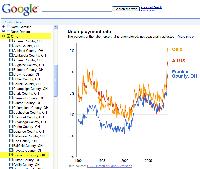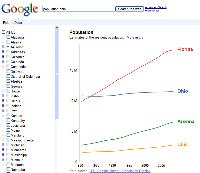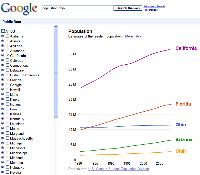"These Are the Times that Tax Men's Souls" —Thomas Paine (1773)
No, Paine wasn't talking about tax time. He was writing about more serious matters. We're just half a month down the road from tax time and if you were one of the people who had to scramble during the first 3 months of the year just to put your hands on the records you needed to file your federal, state, and local tax returns, maybe you'd like a little help next year. Intuit has been in the business of providing that help for a lot of years. The company's offerings range from a free on-line service that offers a modest amount of control over your finances to more expensive (and expansive) applications that record home and small business finances.
Today we have Jim Delfavero, group product manager for Intuit:
LISTEN: Jim Delfavero 15:45
Do Your Now or Did You Ever Stac Your Disk?
If you remember when hard drives were small and expensive, you may also remember Stac Electronics, a company that made it possible to effectively double the size of the drive. Stacker was available in two configurations, one that was software only and one that included a hardware component. A friend reminded me of Stacker recently, and I started wondering what had happened to the company.
According to a Wikipedia article, Stac Electronics was the creation of 7 students at the California Institute of Technology (Caltech) in Pasadena. Stacker wasn't the company's first product, but it was their big hit. When 20 megabyte hard drives cost hundreds of dollars, users were desperate to find more storage space. Founded in 1983, Stac invented the Stacker Disk Compression program in 1990.
As an extra bonus, Stacker usually increased system performance even though data had to be compressed and decompressed on the fly. That operation was faster than read and write operations on slow disks and, with Stacker in place, read and write operations were reduced. The hardware version of Stacker provided slightly more compression than the software version alone.
Disk compression differs from file compression in that a disk compression system doesn't have to be told which files to compress; it compresses everything. The user doesn't even need to know it's there. That's both an advantage and a hazard. The compressed drive is usually stored as one large hidden file and some people who used utility applications to examine their disk drive decided that they could save a lot of space by deleting that big file. People who did that lost all of their data.
The Wikipedia article reminded me of Stac's legal action against Microsoft: "In 1993, Microsoft released MS-DOS 6.0, which included a disk compression program called DoubleSpace. Stac executives were outraged, as Microsoft had previously been in discussions with Stac to license its compression technology." Microsoft had talked with Stac engineers and had examined Stac's code, so Stac charged Microsoft with infringement of two of its data compression patents. In 1994, Stac won a $120 million award, but Microsoft appealed and filed a counter-suit claiming misuse of a trade secret by Stac. Although Microsoft won that case, the award was for just $13.6 million.
By the end of 1994, Microsoft and Stac had compromised. Microsoft invested about $40 million in the company and paid an additional $43 million in royalties.
As disk drives became larger and cheaper, there was no longer a market for disk compression applications. Stac changed its name to Previo and attempted to become a provider of help-desk technology. The timing was bad and the dot-com collapse ended the company's hopes for survival. "In an unusual move," the Wikipedia article notes, "rather than spend all its cash, the company sold off its technology (to Altiris) and returned its cash to its shareholders before dissolving."
Short Circuits
Google Can See You
Google Public Data is the latest offering from Google. So far, it doesn't amount to much, but there's a huge potential. In short, Google Public Data's goal is to accumulate public data from various government agencies and make it easy to use. When I say that it doesn't amount to much yet, I mean that the only information available is the unemployment rate and population, but you can compare any county in the country to any other county, to the state the county is in (or some other state), or to the nation.
Click any of the images here for a full-size view.
 For example, here's a chart that shows 3 graphs: The overall US unemployment rate, the rate for Ohio, and the rate for Franklin County. Note that this is the raw rate, not the seasonally adjusted rate, which means that if you're out of work during a season when a lot of other people are out of work, your being out of work doesn't count for as much. Actually, that's the cynical approach. Seasonally adjusted rates help us understand the real situation. Without seasonal adjustment, it's like comparing prices from the 1960s to today's prices. (Gasoline at 25 cents per gallon and a full-size car for $1500; but to understand the implications, it's important to note than a high-paying job in those years would have meant $10,000 per year.)
For example, here's a chart that shows 3 graphs: The overall US unemployment rate, the rate for Ohio, and the rate for Franklin County. Note that this is the raw rate, not the seasonally adjusted rate, which means that if you're out of work during a season when a lot of other people are out of work, your being out of work doesn't count for as much. Actually, that's the cynical approach. Seasonally adjusted rates help us understand the real situation. Without seasonal adjustment, it's like comparing prices from the 1960s to today's prices. (Gasoline at 25 cents per gallon and a full-size car for $1500; but to understand the implications, it's important to note than a high-paying job in those years would have meant $10,000 per year.)

 I also tried the population chart. In this case, you're limited to states, so I thought I'd look at Ohio, Utah, Florida, and Arizona. Florida, Arizona, and Utah are gaining population and Ohio is holding steady. But add California and see what happens!
I also tried the population chart. In this case, you're limited to states, so I thought I'd look at Ohio, Utah, Florida, and Arizona. Florida, Arizona, and Utah are gaining population and Ohio is holding steady. But add California and see what happens!
You can start from Google.com and type either "unemployment" or "population" and the name of a state.
Google's blog says this is (surprise!) just a start and that the application is (bigger surprise!) still in beta. (Has Google ever taken any product out of beta?) "There are statistics for prices of cookies, CO2 emissions, asthma frequency, high school graduation rates, bakers' salaries, number of wildfires, and the list goes on," says Product Manager Ola Rosling. "Reliable information about these kinds of things exists thanks to the hard work of data collectors gathering countless survey forms, and of careful statisticians estimating meaningful indicators that make hidden patterns of the world visible to the eye. All the data we've used in this first launch are produced and published by the U.S. Bureau of Labor Statistics and the U.S. Census Bureau's Population Division. They did the hard work! We just made the data a bit easier to find and use."
This is possible because Google acquired Trendalyzer two years ago. This is a company that created products to make data more readily available by converting it to visual form.
Do You Want the Windows 7 Release Candidate?
Everything I've heard tells me that Windows 7 will be a lot better than Vista. Unfortunately, at the moment I don't have a spare machine to load the operating system on. This time around, though, Microsoft is doing something that's highly unusual: The release candidate version (which should virtually identical to the final product) will continue to run until June 1, 2010. So if you install it now, you get to use Windows 7 for free for a year. This is a bit of a gamble on Microsoft's part, but a lot of users will be reluctant to pay for an update after their Vista experience. This may attract some early adopters.
The release candidate is available now for Microsoft TechNet subscribers and those who belong to the Microsoft Developers Network. Anyone who wants to try it will be able to download a copy starting May 5th. The release candidate will be on Microsoft's website at least until the end of June, and possibly longer.
Microsoft's longest-living release candidate prior to this was Vista release candidates 1 and 2, which ran for 8 months.
When will the gold code be released to manufacturing? If you're wondering that, Microsoft isn't saying. But there are strong hints that this will be the only release candidate, which suggests that Microsoft is confident that no significant bugs will emerge. The time between RTM and product availability on the shelf is usually 2 or 3 months, with OEM versions on new computers appearing a few weeks earlier.
Talking About Adobe at the Columbus Computer Society
I'll have the opportunity to show some of the features that I've talked about on TechByter Worldwide. In the interest of allowing everyone to get home well before midnight, I'll have to seriously limit the number of features I can show, but I'll try to use your time wisely.
- Columbus Computer Society at OCLC, Kilgour Building, 6565 Kilgour Place, Dublin, Ohio.
The meeting starts at 7pm on May 20.
View Larger Map
The public is welcome.


 The author's image: It's that photo over at the right. This explains why TechByter Worldwide was never on television, doesn't it?
The author's image: It's that photo over at the right. This explains why TechByter Worldwide was never on television, doesn't it?
